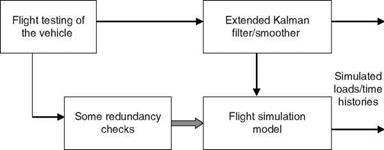Flight Simulation Model Validation for a Rotorcraft
The flight-control system should be evaluated in a nonlinear simulation mode with a larger portion of the flight envelope and with larger amplitude maneuvers. For this purpose the nonlinear control system elements, like rate limiting, etc., should be modeled and included in the flight simulator evaluation experiments.
A systematic approach to flight simulation model validation for a rotorcraft would have the following specific aims [18]: (1) to identify a consistent set of vehicle states and inputs. The data-processing methods should be employed to check the consistency and these data must be consistent to justify model changes based on the flight test data; (2) the aerodynamic loads should be estimated from the flight test data. This is a major uncertainty in rotorcraft simulation. These estimates must be compared with simulation results for identical flight conditions; (3) once the discrepancies are identified, the math model of the vehicle (rotorcraft) should be upgraded using the model structure determination and parameter-estimation methods by matching the flight test results. The idea is to drive both the simulation flight controls and the simulation states with the flight test time histories (see Figure 6.9). If the aerodynamic loads compare well, then the trajectories should match well when the fuselage DOF equations are integrated. If these loads do not match, then the simulation is not generating some of the aerodynamic loads. The KF/smoother estimates biases and misalignment errors and reconstructs the net aerodynamic forces and moments. If there is a mismatch, then a comparison between simulated and measured flapping should be done to isolate the problem. This could identify a problem in the main rotor. The regression method was used to identify correlation between the simulation error and the vehicle states and the structure of the math model was upgraded for the US Army/McDonnell Douglas AH-64 Apache attack helicopter [18]. This is a practical example of the use of system identification and state-estimation methods for validation of nonlinear helicopter simulations from the flight test data.
Estimated
loads/time
histories
|
|












